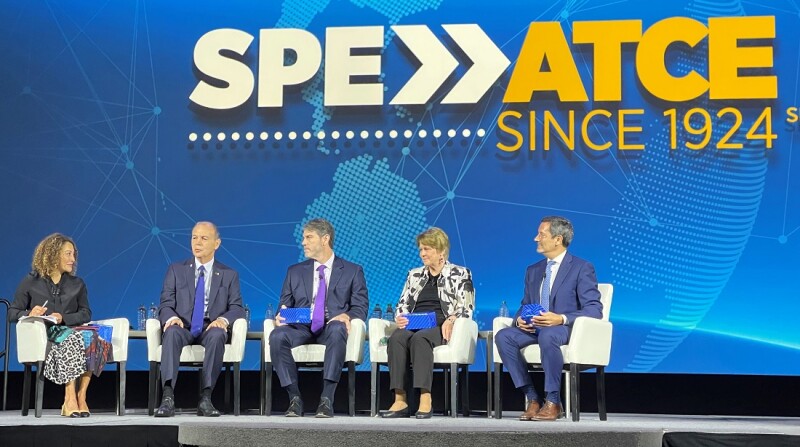The 2022 SPE Annual Technical Conference and Exhibition got under way in earnest on Monday by addressing one of the more pressing questions in the oil and gas industry: Where does it fit in the surging energy transition?
The opening general session was titled “Sustainable Recovery,” but the discussion mostly revolved around how major companies can contribute to society’s movement away from carbon-based energy.
The panel was moderated by Iman Hill, CEO of the International Association of Oil and Gas Producers, who wasted no time in defining the ills of the energy sector and assigning blame.
“As the world slowly came out of the COVID era, we hoped for a smooth recovery that never materialized,” she said. Energy CEOs, she added, must now navigate a wide range of problems, including supply-chain issues, skilled-workforce shortages, and inflation concerns, “all against a backdrop of fluctuating oil prices.”
Continuing to build a foundation for discussion, she reminded the audience of the industry’s various pledges made to reduce emissions and work toward the goals laid out by the Paris Agreement. Social-responsibility worries rounded out the list of concerns that keep oil and gas CEOs up at night.
“There is a building backlash from parts of society who argue that our industry is using the situation in Europe as an opportunity to continue producing unwanted hydrocarbons that threaten our very existence. I find this incredible given the energy crisis we all, not just Europe, are facing.”
She alluded to a recent speech given by Amin Nasser, the CEO of Aramco, who called energy transition plans “sandcastles that waves of reality have washed away” and blamed current woes on poor planning and weakening investment.
“The industry has insisted for years that, if investments in oil and gas continue to fall, global supply growth will lag behind demand, impacting markets, the global economy, and people’s lives. Since 2014, oil and gas investments have fallen from $700 billion to a little over $300 million. Couple this with no contingency planning, and it is plain to see why we are in this situation.”
Panel members at Monday’s opening session were Kamel Ben-Naceur, the president of Nomadia Energy Consulting and SPE’s 2022 president; Barton Cahir, the senior vice president for upstream portfolio development with ExxonMobil; Vicki Hollub, the president and CEO of Occidental Petroleum; and Olivier Le Peuch, the CEO of Schlumberger.
Cahir underscored Hill and Nasser’s laments about the decline in oil and gas investment but presented hope for the future. “Everybody recognizes the need for more oil and gas investment,” he said. “And they recognize it’s going to be there through the energy transition.”
While talking about how the energy transition manifests differently in different parts of the world, Ben-Naceur put a fine point on the problem. “You see across the world very, very different ways of looking at the energy transition,” he said, “but the main thing is that we need to invest in energy.”
Hollub was resilient when considering the social turmoil surrounding oil and gas and the transition. “Despite the pressures, despite what people outside our industry are saying, we have to stay the course,” she said. “We have to do what we do, we just have to do it better.”
In addition to flagging investment in the industry, two other sticking points repeatedly punctuated the discussion: carbon and emissions.
“People forget when they’re thinking about the oil and gas industry that the discussion should not be about the fuel source,” Hollub said. “The discussion has to be about what we do with emissions. The reality is there’s too much passion, unbridled passion and undirected passion, around the world about killing fossil fuels when really that passion should be how do we collaborate together and how do we pull together and solve what is one of the world’s greatest problems today.”
Cahir added that oil and gas will remain a large part of the energy mix in the future. “But it’s not an ‘either/or’ thing; it’s an ‘and’ thing,” he said. “You can grow production and reduce emissions.
“By the end of this decade, we’re going to be at net-zero total emissions from our Permian Basin operations while continuing to grow production. … substantial growth delivered against the backdrop of declining emissions, so the ‘and’ proposition is possible.”
Beyond the problem of emissions, the carbon conundrum had some seeing opportunity. Hollub said Oxy is going deep on carbon capture and sequestration, working with a cement manufacturer as well as other CO2 producers to keep carbon out of the atmosphere.
“There is no doubt that, no matter what model you look at, no matter who puts it together, carbon capture use and sequestration has to be a part of the mix,” she said. “Without that, we cannot cap global warming to 1.5 degrees. It just can’t happen.”
But catching the carbon at the source is only the beginning. Oxy is also working on direct air capture.
“One way we can control our own destiny and do it at a pace we think is right is to build a direct air capture facility,” she said. “This facility will use radial fans to pull air from the atmosphere, push it through a contact tower, and then convert it into CO2 that we will then sequester in the reservoir. The reason that this is so important for us is that it has so many synergies with our chemical business and it has the infrastructure in the Permian Basin to support it.”
She predicted that Oxy’s carbon-capture efforts will grow to rival its oil and gas business in size. “I believe Oxy is headed toward becoming a carbon management company, she said, adding, “It doesn’t mean we are going to decrease our oil and gas production. It means we are going to increase that production but we do it in combination with building our carbon-capture business.”
And SPE was touted as a driver for the technology needed to face these challenges. Ben-Naceur said he sees the society as “an incubator of innovation.”
And Hollub agreed. “I think that SPE over the years has been a driver of a lot of innovation and a lot of best practices that we share here at this conference,” she said. “If you look at all of the things that have been accomplished in our industry, it’s like, every time our industry faces a challenge, every time we face a situation where our production is in decline, we find a way to change it.”


